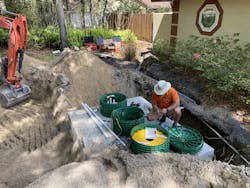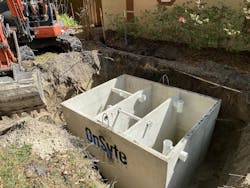A Better Mousetrap
Dr. Brian Lapointe, Ph.D., is a research professor at Florida Atlantic University’s Harbor Branch Oceanographic Institute. Lapointe can be reached at [email protected].
undefinedIn Florida, we have known about this problem for a long time. Excess nitrogen in our waterways linked to nutrient pollution – eutrophication – causes harmful algal blooms. The algal blooms deplete the oxygen in the water and can kill seagrasses and corals, which provide food and habitat for manatees and other aquatic life. The harmful algal blooms also cause fish kills, which are ugly and can make the water unsafe for humans.
Until recently the solutions for mitigating eutrophication were limited and typically expensive, but a new sewage treatment system called distributed wastewater treatment (DWT) is now available that could replace a leading source of reactive nitrogen in the forms of ammonium and nitrate – septic tanks. Recent tests prove this new technology works, and with widespread application, the problem of harmful algal blooms could be significantly reduced and the state’s waterways restored to a more natural and healthy state.
Dr. Ann Shortell, retired executive director of the St. John’s Water Management District, thinks DWT is a game changer.
“There is no reason why this new method— distributed wastewater treatment — won’t work in any area that has septic systems near water resources,” Shortell said. “DWT looks like an effective solution and I’m very excited about its potential.”
Distributed Wastewater Treatment Effectiveness for Excessive Algae
The problem of accelerated algae growth has been the subject of academic study and public debate for more than 30 years. Scientific research has identified septic tanks as a significant contributor of reactive nitrogen to Florida’s groundwater. This is especially true in areas with high concentrations of homes with septic tanks.
DWT was recently tested in areas of Apopka and St. Cloud, Florida. Meanwhile, a team at Florida Atlantic University-Harbor Branch in Ft. Pierce worked with Onsyte, the developers of DWT systems, and the Florida Department of Environmental Protection (FDEP) to conduct official tests of the system in Lake Hamilton during 2021.
The results of the tests were extremely encouraging:
- Total Kjeldahl Nitrogen (TKN) levels in effluent from the DWT system showed a 90% removal rate, from 125 mg/L to 13 mg/L.
- Ammonia was reduced by 88%, from 80 mg/L to 9.8 mg/L.
- Effluent had 8 mg/L nitrate, lower than the U.S. EPA standard for nitrate in drinking water of 10 mg/L.
- DWT removed 92% of the fecal coliforms, 97% of the total suspended solids, and 98% of the Carbonaceous Biochemical Demand (CBOD).
Why Are Septic Tanks a Problem?
Septic tanks often fail for three reasons: poor maintenance, high groundwater tables, and Florida’s geology. Many septic tanks are decades old and if not maintained properly, do not function well and can allow untreated sewage to escape into the environment. Florida’s typically high water table and porous sandy soils also contribute to the problem as they do not sufficiently treat the effluent from septic systems and allow high amounts of nutrients and other contaminants into the groundwater. These nutrients make their way into local bodies of water where they cause algal growth to explode.
According to the University of Florida Institute of Food and Agriculture, there are 2.6 million septic tanks in the state discharging about 426 million gallons of wastewater per day into Florida’s environment. As a result, the state is seeing an increasing trend in harmful algal blooms in freshwater, estuarine and marine environments in urbanized areas of Florida, a double whammy for both Florida residents and the tourism industry.
DWT vs. Traditional Solution Costs
In the past, some cities have solved the problem by building municipal wastewater treatment systems. This is a great solution, but it is not always a practical one. Smaller communities struggle to come up with sufficient funding for treatment plants and collection systems. Installing underground pipes can be extremely difficult in many areas of Florida because of its high water table, sandy soils and limestone geology. Problems like these can make installation of infrastructure cost millions and take years, if not decades, to complete.
DWT systems seem to be the proverbial “better mousetrap.” DWT technology solves the problems created by septic systems and avoids the costs associated with municipal sewer collection and treatment.
“A septic system typically costs about $12,000 installed,” explained Bryan Nelson, mayor of Apopka, a city of 52,000 located northwest of Orlando. “A distributed wastewater system is about $15,000, so the costs are comparable. Converting a home to a municipal sewer system costs about $50,000, so you can put in three DWT systems for the cost of one conversion to a municipal system. The economics alone tell you DWT is a great solution.”
How the Distributed Wastewater Treatment Works
A DWT unit is about the same size as a septic tank, but it treats sewage much differently. DWT has been described as similar to a municipal treatment plant. The process utilizes a three-chambered, suspended-growth activated-sludge sequencing batch reactor with biological nitrogen removal. The effluent it produces is treated to a level that does not require a drain field for percolation, although use of a drainfield can achieve even higher levels of treatment. The relatively low nutrient levels are released into the environment and the treatment process covers a much smaller footprint.
Furthermore, DWT units can be monitored remotely by public works employees. If the unit fails in any way, technicians will be notified and the problem is repaired without involving the homeowner. Typically, homeowners may never know a problem occurred.
“We monitor DWT units at the municipal level with our SCADA (supervisory control and data acquisition) technology,” Nelson said. His city, Apopka, has done a significant amount of testing of DWT units with superlative results. “If anything goes wrong, we notify the OnSyte people and they take care of the problem immediately.”
OnSyte, based in Suwanee, Georgia, is the developer of DWT technology and provides local support for communities that use the system.
How to Transition to DWT
The costs of transitioning communities to DWT systems is, in some cases, being subsidized by grants from the FDEP and the St. Johns River Water Management District, which just completed testing DWT in Lake Hamilton. By all measures, the tests proved that DWT units greatly reduce nitrogen levels in discharged effluent, making the wastewater much safer to release into the environment.
The path to transition is simple enough. Local utility departments or contracted technicians conduct a routine home inspection before permitting a DWT installation. Plumbing modifications are typically unnecessary. Once the unit is installed, the homeowner will notice no change in wastewater disposal. The homeowner pays a monthly wastewater fee similar to the cost of municipal treatment. The system is maintained by the local water treatment district.
A DWT residential unit requires 120V of alternating current on a 20-amp circuit to operate the onboard controller and pumps, sensors, and air compressor. Total electricity usage per month is about 1.3kWh, approximately $4 to $5. Loss of electrical power, however, will not cause backups as the wastewater will continue to flow through the DWT unit and receive minimal sewage treatment even during a power outage; toilets and sinks can be used without issue.
Healing Florida’s Waters
The problem of excessive algal blooms from nitrate pollution has plagued Florida for decades and it is getting worse as its population grows. The tide, however, may be turning as more people transition from septic systems to DWT systems. DWT has shown to significantly reduce the amount of nitrogen entering the environment. As concentrations of ammonia and nitrate in the waterways diminish, Mother Nature begins the healing process, and it does not take long. Soon, local surface waters get cleaner and healthier, seagrasses can grow, fish populations rebound and manatee habitats are restored.
“We must protect our water quality,” Nelson said. “We want the springs and rivers to be healthy and accessible not only for our kids and grandkids, but for our great-great grandchildren, too. We are determined to make a positive impact on our environment, and distributed wastewater treatment may be our best opportunity to solve the problem of accelerated algae growth.”

